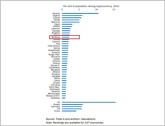
The Moldovan leu (MDL) turns 32 on November 29
To mark the occasion, the National Bank of Moldova (NBM) held its seventh financial education event, The Road of Money, on November 28. The program attracted more than 200 participants—students from large cities and remote villages—who had the opportunity to learn about the circulation of money in the economy in an interactive and accessible way. “The Road of Money is a project through which we help children and young people develop by learning about economic realities. We explain to them not only how money circulates, but also what role it plays in improving quality of life and achieving goals,” said Anca Dragu, Head of the National Bank of Moldova. The journey along “The Road of Money” began at the NBM with a tour of the exhibition hall – a real immersion in the history of the national currency. Visitors learned how the Moldovan leu developed and how it contributed to the development of the economy in the 32 years since its introduction. In addition, participants were able to admire a collection of commemorative and anniversary coins made of gold and silver issued by the National Bank and learn about historically valuable works of coin art. During practical classes, children and teenagers studied the security features of Moldovan leu banknotes, learning interesting information about the stages of their modernization. The journey continued at licensed banks, where visitors learned about the principles of banking and its role in the economy. The aim of the project is to provide children and young people with the necessary support in developing financial literacy, which will enable them to successfully navigate the complex world of the modern economy. The Moldovan leu was introduced into circulation on November 29, 1993. The new currency replaced the temporary currency unit, the coupon, which had been in circulation since June 10, 1992. The 1993 Moldovan leu was replaced in 1994 by a new series, which in turn was updated in 2015. Coins of 1, 5, 10, 25, and 50 bani, as well as 1 and 5 lei, were introduced into circulation, along with banknotes of 1, 5, 10, 20, 50, 100, then 200 and 500 lei. In 2003, a 1,000 leu banknote was introduced. All coins initially had a low level of security, which attracted counterfeiters, who quickly mastered the minting of 50 bani, 1 leu, and 5 leu coins. As a result, in the first years of circulation, the 1 and 5 leu coins were withdrawn from circulation, followed by the 50 bani coin, which was replaced with a more secure version. In 2018, the National Bank issued new coins with denominations of 1, 2, 5, and 10 lei. // 28.11.2025 — InfoMarket.







